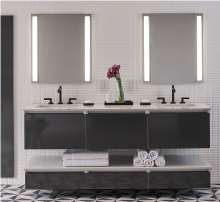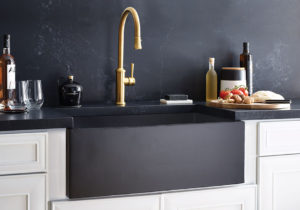Of all of the choices a designer has to make for a bathroom, the decision between using a traditional floor-mount vanity or a more contemporary wall-mount unit is one of the biggest.
One reason the vanity is so important is that unlike the rest of your bathroom—the fixtures, shower, sink, toilet, etc.—the vanity is the one item you have exclusive control over, Superior Home Décor wrote on its website. “The size, the placement, and the actual item you decide to purchase. Your entire theme can be dependent on choosing the correct mirror and trimmings to highlight the bathroom.”

No doubt the size of the vanity unit you choose will be dependent on the size of your bathroom, but the decision to choose a wall-hung unit or a traditional floor-mount vanity is typically more about style and functionality.
According to most trend watchers—from NKBA and Houzz to Home Innovations Research Labs—modern and transitional design tastes are popular for vanities.

“In terms of lifestyle, we see a movement toward modern and transitional amongst all demographics,” says Trevor Tran, the director of marketing for Ronbow Corp. “Space is an essence when it comes to metropolitan cities, where millennials prefer to live, and also with the tiny house hype in the recent years, smart storage is very desirable.”
Tran explains that wall-hung vanities fit right in with this trend, which is one reason they are the hottest style on the market. “Wall hung vanities have transitioned from contemporary to a transitional style over the last few years,” Trans says. “With the expansion of styles in the category, this makes it more attractive for all home decor.”

Wall-hung vanities give customers flexibility to install to whichever height they’d like, Tran explains. Additionally, wall-hung vanities make the bathroom feel spacious and airy, and it’s easier to clean underneath them. In terms of style, wall-hung units can offer nice clean lines with updated design that can fit any style of bathroom.
James Lentaigne, director of sales and marketing for Drummonds, adds that wall-hung vanities require less space, which means they work in many smaller bathrooms. Plus, he says, the product is easily adaptable to smaller baths, but can work equally well in a large bathroom.

“Over the past 10 years we’ve seen vanities morphing from a simple ‘box’ shape into products that are more of a design element,” says Bob Gifford, director of bath products at Hastings Tile & Bath. “There are myriad materials to work with, many more finishes and styles, and the biggest change seems to be the increased interest in moving that ‘box’ off the floor.”
But wall-mount vanities also have their drawbacks and, thus, may not be for every project. For one thing, the wall has to be prepped during the framing stage to provide adequate support for installation. Because the vanity units tend to be smaller, they offer less storage space, so designers will be forced to provide additional storage. Moreover, wall-hung units tend be more contemporary in style. If a homeowner wants a traditional-style unit, it may not suit their needs.

Of course, floor-standing bath vanities are still pretty popular with homebuyers and consumers, but the average product offers more finish options, styles, colors, and features. “Boring cabinets are out and interesting freestanding vanities are more in favor,” says Lentaigne.




